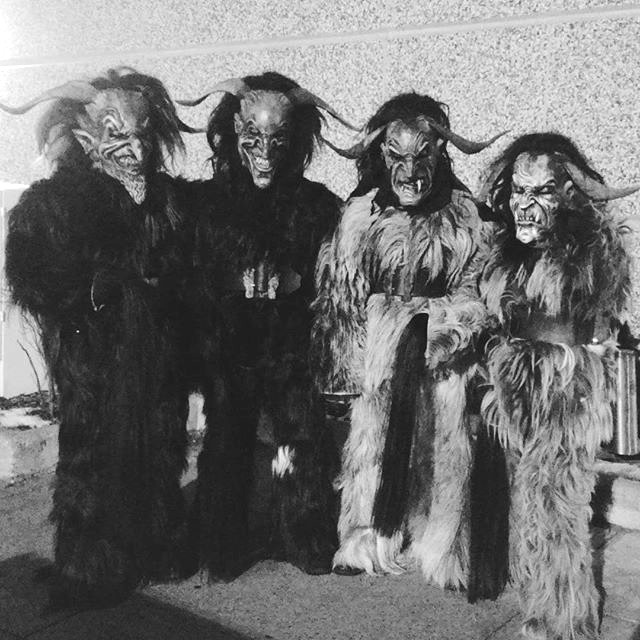While Santa might have his naughty and nice lists, in some places there’s more for misbehaving children to fear on Christmas than a handful of coal from the jolly red man. Anyone familiar with Alpine traditions (or the 2015 horror movie based on them) knows about Krampus, a beast who accompanies Saint Nicholas around the holiday season. In the greater Twin Cities area, a collective of Krampus fans is bringing that tradition to life.
“Krampus is a creature covered in fur with four to six horns,” said Tyrone Schenk, the president of Minnesota Krampus and a graduate of the University of Minnesota. “They’re larger than a human, and they hunt mountain passes in search of naughty children.”
Minnesota Krampus is a local Krampus organization that celebrates and teaches about the Alpine Christmas tradition. The group also supports scholarships for students studying the Alps.
“As an educational nonprofit, we do a lot of festivals where we have a booth and explain our tradition, and we also have some events where we dress up,” Schenk said.
Along with its educational efforts, Minnesota Krampus is also known for its more horrific events aimed towards adults. Last Friday, Minnesota Krampus made an appearance with Impaler, a Twin Cities horror-rock band whose shows feature fake blood, coffins and severed heads.
“At the 21+ events, we don’t do as much education. We dress up, and we party with people and rock out and have a good time,” Schenk said. “Sometimes the events want us to be really loud and rambunctious, and we’ll have a whole pack or herd. We’ll pose for pictures as people want, but we’re not going to get up in people’s faces.”
Drawing on Austria’s long tradition of craftsmanship, Minnesota Krampus sources handcrafted Krampus costumes from artisans.
“Our masks are carved by this master woodcarver… They affix horns onto the mask… and our suits are long-haired Austrian goat fur,” Schenk said.
Despite Krampus’s terrifying appearance and appetite for children, Krampus’s youngest fans are typically the most accepting and curious.
“It’s pretty much either people ignore us, are extremely confused or are extremely interested,” said Eli Cizewski-Robinson, a graduate of the University who volunteers with Minnesota Krampus. “It’s surprising how few people are afraid, even with kids it’s more confusion or ‘I want to find out what this is.’”
Minnesota Krampus, however, would encourage parents to look beyond Krampus’s potential to scare young children and his ability to teach them a valuable lesson.
“It’s a tradition that’s been going on for hundreds of years, and there are consequences in life to not doing the right thing and being bad,” said Jake Schultz, a member of Minnesota Krampus. “It doesn’t necessarily have to be a monster coming to get you — it could be other things. Teaching children right versus wrong is beneficial in the long run.”
Krampus was originally a pagan legend used to explain the unknown.
“It’s seeped in this Germanic paganism, focusing on things that go bump in the night and explanations of why certain things happen, why certain people get injured when they’re on mountain passes… Maybe the Krampus got him,” Schenk said.
The tradition was then linked to Saint Nicholas during the Christianization period of the Alpine regions and died out during the period of Nazi reign, making many current Krampus organizations relatively new.
The Internet age, however, has allowed the legend of Krampus to live on.
“In the Internet age… it’s just exploded. The ability for the stories to cross borders and be relatable to others is amazing,” Schenk said.
Even the 2015 movie “Krampus” has drawn attention to groups like Minnesota Krampus, although the plot ignores some elements of the tradition.
“I think largely any publicity is good publicity. Hollywood has a tendency, from my perspective, to take some really good ideas and then make it fit the movie,” Schenk said. “My tradition would not look as good in a movie setting, so they have to take a certain amount of a creative license to the movie… but I think [the movie] did make some steps towards making organizations like ours readily accepted.”
As Minnesota Krampus continues to grow, its members imagine Krampus’s influence spreading across the country.
“For me, success is having people understand and recognize and appreciate and not otherwise shun the tradition,” Schenk said. “There are so many Christmas markets now… I would love to get to a size where we could do two or three events at the same time.”
Ultimately, Krampus’s popularity and persistence are derived from the tradition’s connection to widespread morals.
“It’s who we are. There’s a lot of wisdom in remembering how things used to be and preserving who we are as people in any culture,” Schultz said. “It helps promote tolerance and understanding for any culture to be able to share things their ancestors they did.”








